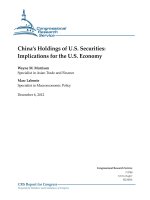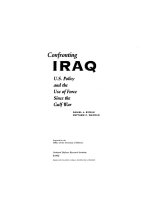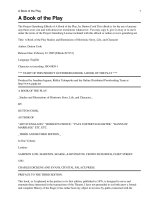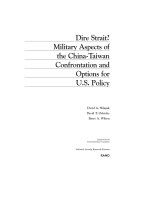Dire Strait? Military Aspects of the China-Taiwan Confrontation and Options for U.S. Policy pptx
Bạn đang xem bản rút gọn của tài liệu. Xem và tải ngay bản đầy đủ của tài liệu tại đây (332.09 KB, 111 trang )
Dire Strait?
Military Aspects of
the China-Taiwan
Confrontation and
Options for
U.S. Policy
National Security Research Division
David A. Shlapak
David T. Orletsky
Barry A. Wilson
Supported by the
Smith Richardson Foundation
R
The research described in this report was sponsored by the Smith
Richardson Foundation. The research was conducted within the
International Security and Defense Policy Center of RAND’s National
Security Research Division.
RAND is a nonprofit institution that helps improve policy and
decisionmaking through research and analysis. RAND
®
is a
registered trademark. RAND’s publications do not necessarily reflect
the opinions or policies of its research sponsors.
© Copyright 2000 RAND
All rights reserved. No part of this book may be reproduced in any
form by any electronic or mechanical means (including
photocopying, recording, or information storage and retrieval)
without permission in writing from RAND.
Published 2000 by RAND
1700 Main Street, P.O. Box 2138, Santa Monica, CA 90407-2138
1200 South Hayes Street, Arlington, VA 22202-5050
RAND URL: />To order RAND documents or to obtain additional information,
contact Distribution Services: Telephone: (310) 451-7002;
Fax: (310) 451-6915; Internet:
Library of Congress Cataloging-in-Publication Data
Shlapak, David A.
Dire strait? ; military aspects of the China–Taiwan confrontation and options for
U.S. policy / David A. Shlapak, David T. Orletsky, Barry Wilson.
p. cm.
“MR-1217-SRF.”
Includes bibliographical references.
ISBN 0-8330-2897-9
1. Taiwan—Military policy. 2. China—Military policy. 3. United States—
Military policy. I. Orletsky, David T., 1963– II. Wilson, Barry, 1959– III. Title.
UA853.T28 S55 2000
355'.03355124'9—dc21
00-062657
iii
PREFACE
Even a half century after the birth of the People’s Republic of China
(PRC), the Taiwan Strait remains the locus of one of the most dan-
gerous military confrontations in the world. In recent years, a series
of Chinese military exercises coupled with the ongoing modern-
ization of the People’s Liberation Army (PLA) have seemed to raise
the stakes in this long-standing staredown and likewise increased its
visibility, especially in the United States.
Until 1979, the United States was Taiwan’s primary security partner.
Today, it remains linked to the island by both force of law and a nat-
ural affinity toward a rapidly democratizing polity embedded in a
vibrant market economy. But Washington at the same time is pursu-
ing improved relations with Beijing as well as encouraging the PRC’s
deeper integration with the international system at large. Because
the status of Taiwan may be China’s single most neuralgic point, the
United States is compelled to perform a delicate balancing act—
attempting to fulfill its obligations and inclinations toward ensuring
the Republic of China’s (ROC) survival without making an enemy of
the mainland.
This report looks at the near-term military balance between China
and Taiwan. Mixing quantitative and qualitative analysis, it explores
a range of key factors that affect the ROC’s self-defense capabilities
and suggests ways that the United States can effectively contribute to
improving the odds in Taipei’s favor.
This report was written as part of a project on assessing Taiwanese
defense needs, sponsored by the Smith Richardson Foundation.
Research for the report was conducted within the International
iv Dire Strait?
Security and Defense Policy Center of RAND’s National Security
Research Division (NSRD), which conducts research for the U.S.
Department of Defense, for other U.S. government agencies, and for
other institutions. Publication of this report was supported in part
by the Strategy and Doctrine program of Project AIR FORCE.
v
CONTENTS
Preface iii
Figures vii
Tables ix
Summary xi
Acknowledgments xxi
Abbreviations xxiii
Chapter One
INTRODUCTION 1
Confrontation in the Taiwan Strait 1
The U.S. Role 2
The Purpose of This Study 3
Structure of This Report 4
Chapter Two
SCENARIO AND APPROACH 7
A Chinese Invasion of Taiwan 7
Analytic Structure and Methodology 9
Scoping the Problem 9
Air War Methodology 12
Naval War Methodology 18
Caveats 18
Orders of Battle 19
Air, Air Defense, and Missile Forces 19
Naval Forces 20
Command and Control 23
vi Report Title
Playing Out the Scenario 24
Overview 24
The War in the Air 24
The War at Sea 30
Chapter Three
ISSUES AND IMPLICATIONS 31
Air Superiority 31
Base Operability 31
Advanced Air Weapons 34
Training Quality 36
The Value of U.S. Involvement 38
Maritime Superiority 40
The ASW Dilemma 40
Maintaining a Credible Antisurface Warfare
Capability 42
The U.S. Role 43
Summing Up 45
Chapter Four
RECOMMENDATIONS AND CONCLUDING
REMARKS 47
U.S. Support Is Vital to Taiwan’s Security 47
Small Increments of U.S. Assistance Could Turn the
Tide 48
Supporting Taiwanese Modernization: The Israel
Model 49
Air Defense C
2
51
Information and Intelligence Sharing 51
Interoperability: The Critical Link 52
China as a Sanctuary? 54
Looking Beyond 2005 55
Final Thoughts 56
Appendix
A. Some Thoughts on the PRC Missile Threat
to Taiwan 59
B. Overview of the JICM 63
References 85
vii
FIGURES
2.1 Overall Outcomes 26
3.1 Effects of Reductions in ROCAF Sortie Rates 32
3.2 Effects of BVR Capabilities on Case Outcome 35
3.3 Effects of ROC Training on Case Outcome 37
3.4 Overall Effect of U.S. Involvement 39
3.5 Effect of U.S. Involvement on Air Outcomes,
Advanced Threat 40
B.1 Fraction of Package with First Shot 69
B.2 D-Day Sorties 76
B.3 D-Day Sortie Losses 77
B.4 D-Day Aircraft Losses and Sorties 77
ix
TABLES
2.1 PLAAF Forces Committed to Taiwan Contingency 14
2.2 Chinese Missile Forces 15
2.3 Cases for Exploratory Analysis 18
2.4 ROCAF Composition 19
2.5 Taiwan Surface-to-Air Order of Battle 20
2.6 Taiwanese Naval Order of Battle 21
2.7 Chinese Naval Order of Battle 21
2.8 Impact of Parameters on “Red” Outcomes 27
B.1 Mission Packages 74
B.2 Package Timing 75
B.3 Aircraft Data 79
B.4 Engagement Rates and First Shots 80
B.5 Air-to-Air Weapon Data 80
B.6 Training Factors 81
B.7 Air-to-Air Weapon Loads 81
B.8 Air-to-Air Exchange Rates 82
B.9 Air-to-Ground Weapon Data 83
B.10 Air-to-Ground Weapon Loads 83
B.11 Ground-to-Air Weapon Data 83
xi
SUMMARY
OVERVIEW
As the new century dawns, the Taiwan Strait is the locus of one of the
world’s most dangerous flashpoints. Two entities share the name of
“China”: one, the most populous country in the world, is a gargan-
tuan and unique hybrid of Communist ideology and capitalist
appetite, while the other is a tiny island republic of great wealth and
uncertain international status. And across the narrow barrier of the
Taiwan Strait, these two powers—the People’s Republic of China
(PRC) and the Republic of China (ROC)—stare at each other.
The United States plays an interesting role in this pas de deux, part
observer and part participant. For 30 years after 1949, it was Tai-
wan’s principal patron, maintaining a mutual defense treaty with the
ROC. When the 1970s brought a “normalization” of relations
between Washington and Beijing, this era of close cooperation
ended. Since 1979, the U.S. government has maintained a calculated
ambiguity in its policy toward the deadlock over Taiwan’s status.
This balancing act has been complicated recently by such events as
China’s 1995 and 1996 missile tests, in the wake of which Taiwan’s
security situation has gained new visibility in Washington, where
concerns have been raised about whether the United States is doing
enough to ensure the island’s self-defense capabilities.
This monograph reports the results of a project that examined the
military dimensions of the confrontation between China and Tai-
xii Dire Strait?
wan.
1
Using a mixture of qualitative and quantitative analysis, we
have done two things:
• Identified a handful of issues that appear crucial in helping Tai-
wan maintain an adequate defensive posture vis à vis the PRC,
and
•Developed a set of recommendations for steps the United States
might take to assist Taipei in dealing with those issues.
SCENARIO AND APPROACH
Although coercive scenarios (e.g., limited missile strikes) are usually
regarded as the more likely form of Chinese use of force against Tai-
wan, we assessed the more extreme case of an outright air and
amphibious invasion of the island. We chose to focus on this chal-
lenging contingency for six reasons.
• Some analysts argue—in contrast to the conventional wisdom—
that “immediate and full-scale invasion” is the most likely form
of conflict between the two sides.
• As the “worst-case” scenario, it is of interest to military planners
whose responsibility it is to deter potential adversaries from dan-
gerous courses of action.
• The possibility of a direct Chinese invasion of Taiwan—and
expectations regarding the outcome of such an attack—is impor-
tant in shaping overall perceptions of the balance between the
two sides.
• The seizure and holding of the island is the only alternative that
guarantees Beijing’s control when hostilities end. So, in some
___________
1
That this report focuses on military issues should not be interpreted as
suggesting that the crux of the China-Taiwan issue is military; neither do
the authors believe that military means are the only or even the most
likely way of resolving the dispute. Our given task has been to examine
the balance of power across the strait, not to document, explicate, or
predict the complex political dynamics at the heart of the differences
between Taipei and Beijing. We recognize that a strongly deterrent
Taiwanese posture is only one part—albeit a vital one—of the equation for
maintaining peace and stability on the strait and in East Asia.
Summary xiii
sense, the credibility of the invasion threat underwrites the other,
lower-level options, such as limited missile strikes or maritime
harassment.
• While it seems unlikely that China would undertake such a des-
perate gamble, it is important to think through the manner in
which the People’s Liberation Army (PLA) might essay the oper-
ation and what steps would be needed to defeat it. After all, it
was always terribly unlikely that the Soviet Union would launch a
massive nuclear attack on the United States. Still, hundreds if
not thousands of war games, exercises, and analyses were
invested in exploring the “what-ifs” of that contingency.
• An invasion scenario incorporates a number of elements that
could be components of other coercive strategies directed
against Taiwan. Perhaps most significant is the employment of
conventionally armed surface-to-surface missiles (SSMs) against
targets in Taiwan.
Analytically, an invasion campaign can be divided into four seg-
ments:
• In the first phase, the two sides would fight for air superiority.
• The second phase, which could begin simultaneously with the
first, would be a struggle for maritime control of the strait.
• Followup air strikes would focus on “softening up” the island’s
defenses.
• The fourth phase would involve actual landing operations and
could include amphibious landings, paratroop assaults, and
heliborne attacks.
Our attention is focused mainly on the battle for air superiority and,
secondarily, on the contest for control of the seas. Control of the air
and control of the sea are absolute prerequisites for a successful
amphibious and/or airborne assault. This may be particularly true in
the context of a PRC attack on Taiwan. The People’s Liberation Army
Navy (PLAN) owns enough amphibious lift to move about a division
of troops at a time, hardly enough to establish and sustain a firm
foothold in the face of determined Taiwanese resistance. Therefore,
many analyses picture a kind of “Dunkirk in reverse,” with China
xiv Dire Strait?
employing numerous commercial vessels to transport troops,
equipment, and supplies across the strait. Such an operation, involv-
ing unarmed merchant shipping, would be sheer folly unless China
had secured almost uncontested dominance of the air and sea. Simi-
larly, the kind of large-scale airborne and air assault operations often
suggested as part of a PRC attack would be virtually suicidal unless
the ROC’s air defenses had been thoroughly suppressed. Finally, the
surface forces of the two navies consist of warships with very limited
air defense capabilities. In the absence of air superiority, the PLAN’s
warships would be very vulnerable to air attack in the confined
waters of the strait. We therefore conclude that the battle for air su-
periority in particular is the linchpin of the campaign.
We chose RAND’s Joint Integrated Contingency Model (JICM) as the
primary modeling tool for this study; developed for the U.S. Depart-
ment of Defense, JICM is a theater combat model designed to sup-
port the kind of exploratory analysis that we emphasized in this
project. After preparing a database from open-source materials and
making an initial set of runs to identify the factors that seemed likely
to play a determining role in the outcome of the war over the strait,
we conducted more than 1,700 model runs to examine the impact of
seven key variables:
• The size and composition of the air forces committed to the
attack by the PRC.
• Each side’s possession of beyond-visual-range (BVR), “fire-and-
forget” medium-range air-to-air missiles (AAMs).
• The number and quality of short- and medium-range ballistic
missiles (SRBMs and MRBMs) used by the Chinese.
• The number of advanced precision-guided munitions (PGMs),
such as laser-guided bombs (LGBs) and Global Positioning Sys-
tem (GPS)-guided weapons, in the Chinese inventory.
• The ability of the Republic of China Air Force (ROCAF) to gener-
ate combat sorties.
• The quality of the ROCAF’s aircrew.
• The extent, if any, of U.S. air forces, both land and sea based,
committed to Taiwan’s defense.
Summary xv
Our more-limited analysis of the naval war was undertaken using the
JICM and Harpoon, a computer-based simulation of maritime war-
fare. Harpoon is widely considered the best commercially available
depiction of modern maritime combat. It includes representations
of submarine, surface, and air warfare.
This work explores only a very limited region of what is often referred
to as the “scenario space.” We concentrated on one specific scenario
involving one particular Chinese offensive strategy, and we selected
the factors to vary based on our reading of the extant literature on the
China-Taiwan balance as well as discussions with experts in the
United States and elsewhere. We also focused our attention on what
might be thought of as “reasonable” cases: those reflecting current
capabilities, linear projections of current capabilities, and capabil-
ities conceivably attainable within our limited time frame. As such,
we present these results as illustrative and indicative, meant to high-
light and illuminate certain key points that emerged from our overall
analysis.
Because our notional war is set in 2005, the two sides’ orders of battle
consist largely of systems already present in their arsenals. We varied
the size and composition of the PRC air and missile forces commit-
ted to the campaign to reflect uncertainties regarding the pace and
scale of China’s military modernization programs.
The analysis required many assumptions, and the problem fre-
quently arose as to how much credit to give the protagonists for vari-
ous capabilities. We decided to credit both sides with taking
measures to increase their competence in critical areas. In particu-
lar, we credited the Chinese with more capability than they have
actually demonstrated in conducting complex offensive operations.
And we assumed that Taiwan would be able to maintain the basic
functionality of its command and control (C
2
) system, even under the
stress of a concerted PRC attack.
2
Because of these assumptions, our
analysis is less a current net assessment of actual capabilities on the
two sides than it is an assessment of reasonable potential capabilities
with given orders of battle.
___________
2
I
ncluding possible, but unmodeled, information warfare operations.
xvi Dire Strait?
RESULTS, IMPLICATIONS, AND RECOMMENDATIONS
Our analysis suggests that any near-term Chinese attempt to invade
Taiwan would likely be a very bloody affair with a significant proba-
bility of failure. Leaving aside potentially crippling shortcomings
that we assumed away—such as logistics and C
2
deficiencies that
could derail an operation as complex as a “triphibious” (amphibious,
airborne, and air assault) attack on Taiwan—the PLA cannot be con-
fident of its ability to win the air-to-air war, and its ships lack ade-
quate antiair and antimissile defenses. Provided the ROC can keep
its air bases operating under attack—a key proviso that we will dis-
cuss at length in the next chapter—it stands a relatively good chance
of denying Beijing the air and sea superiority needed to transport a
significant number of ground troops safely across the strait. Overall,
the ROC achieved “good” outcomes in almost 90 percent of the cases
against our best-estimate “base” PRC threat. Both in the air and at
sea, attrition was extremely high on both sides.
3
We identified seven key findings from our analysis:
• Taiwan’s air bases must remain operable so that the ROCAF’s
fighter force can keep up the fight against the superior numbers of
the PLA Air Force (PLAAF). We recommend increased attention
to passive defense and rapid-reconstitution measures; Taiwan
could learn much from NATO’s response to the threat posed to
its rear area by Warsaw Pact air and missile attacks in the 1970s
and 1980s.
• The ROC must maintain at least parity in advanced air-to-air
weaponry. Ideally, Taiwan would enjoy a unilateral advantage in
this area. At the very least, however, the PLAAF cannot be per-
mitted to field significant quantities of “fire-and-forget” AA-12-
class weapons without Taiwan being similarly endowed with
AIM-120 Advanced Medium-Range Air-to-Air Missiles
(AMRAAMs). The recent decision by the U.S. government to
___________
3
For a variety of reasons, the attrition we calculated may be higher than
would occur in an actual clash between China and Taiwan. Nonetheless,
we believe that such a conflict would feature loss rates that would be
extremely high by historical standards.
Summary xvii
provide AMRAAMs to the ROCAF if China acquires the AA-12/R-
77 is an important and welcome hedge.
• Pilot quality may be Taiwan’s ace in the hole. PLAAF training is
notoriously poor. This makes it even more important for Taiwan
to ensure that their aircrews are of the highest possible caliber.
Our analysis suggests that improved pilot quality may contribute
more to favorable air superiority outcomes than would even siz-
able additions to the ROCAF’s fighter force structure.
• U.S. involvement is important now and will likely grow increas-
ingly vital. Even in the near term, U.S. carrier- and land-based
fighters could make a combination crucial to Taiwan’s defense.
As the PLAAF’s inventory becomes more sophisticated and
capable, Taiwan’s need for U.S. assistance will likewise increase.
• Antisubmarine Warfare is a critical Taiwanese weakness. Absent
an unexpected acquisition of numerous modern attack
submarines, the ROC Navy (ROCN) will have tremendous
difficulty coping with China’s modernizing submarine fleet. We
suggest that Taiwan’s navy consider keeping its main battle
forces out of the strait during the initial phase of a war with the
mainland.
• Fast, stealthy missile boats and highly mobile land-based antiship
missile launchers can help Taiwan exploit its inherent defensive
advantages. If adequate detection and targeting information can
be provided, these weapons could prove highly lethal and rela-
tively survivable even in the chaotic opening hours of a China-
Taiwan clash.
• Again, the U.S. role in the naval campaign could be crucial. U.S.
nuclear-powered attack submarines (SSNs) could help counter
the Chinese submarine threat, U.S. surveillance capabilities
could provide vital support to Taiwanese forces, and Harpoon-
equipped bombers could provide early firepower key to the naval
battle.
Given that it seems unlikely that Beijing will renounce its “right” to
use force to compel unification, a strong Taiwanese deterrent
appears to be a necessary component of continued peace on the
strait. As Taiwan’s most reliable friend and in keeping with the
requirements of the 1979 Taiwan Relations Act, the United States will
xviii Dire Strait?
necessarily play a major role in helping the ROC maintain and
enhance its defensive capabilities even as the PLA modernizes.
Should deterrence fail, Taiwan may find itself in a position where its
survival is dependent on some degree of direct U.S. military inter-
vention.
Our analysis, however, suggests five key insights regarding U.S. sup-
port for Taiwan—in both peace and war—that indicate ways of
enhancing deterrence across the strait. By pursuing initiatives along
these lines, Taiwan’s defense posture vis à vis China could be signifi-
cantly enhanced with, we believe, minimal risk of destabilizing the
situation.
First, the amount of force needed to support Taiwan in the near term
appears to fall considerably short of what is usually thought of in the
Pentagon as that needed to prosecute a major theater war (MTW). In
our analysis, we never committed more than a single wing of land-
based fighters, two carrier battle groups (CVBGs), and a dozen or so
heavy bombers to the campaign—a far smaller force than the 10
fighter wing equivalents and six CVBGs that were engaged in Desert
Storm.
In terms of arms sales and military assistance, our second recom-
mendation is that attention should focus on helping Taiwan get the
most out of its existing inventory of advanced platforms rather than
selling the ROC entirely new weapon systems. Providing key
advanced weapons, such as AMRAAM, improved sensors, and
enhanced training, would be important elements of such a strategy.
Third, Taiwan’s air defense C
2
network, which has been upgraded
substantially in the past decade, continues to suffer from limitations
in intelligence fusion and data transmission. These shortcomings
should be an important priority for rectification. The U.S. side can
encourage Taiwan to make the investments needed to ensure that
the ROC’s C
2
system is fully modernized and robust in the face of the
kinds of threats it would likely face in a conflict with China.
Fourth, the United States is obviously and properly sensitiv e and
selective in choosing how and when to share what kinds of informa-
tion and intelligence with its friends and allies. At the same time,
however, there would appear to be enormous leverage to be gained by
helping Taiwan’s government and military leadership maintain an
Summary xix
accurate picture of the strategic and tactical situation day to day and,
especially, during a crisis. A shared picture of the evolving threat
would also likely make it easier for the two sides to reach agreement
on arms sales and other modes of U.S Taiwan defense cooperation.
Finally, we wish to call attention to the critical problem of inter-
operability, should Taiwanese and U.S. forces ever find themselves
required to fight side by side. This analysis assumed that the United
States and Taiwan had achieved only a minimum level of inter-
operability, but even this may overstate the degree of cooperation
that would be possible if war were to break out today. Enhancing the
ease of cooperation between Taiwanese and U.S. forces—even to the
extent of ensuring that the two countries’ forces can merely stay out
of one another’s way in a crisis—is in the interests of both sides, and
even small and discreet steps could be valuable.
In addition to working with Taiwan to improve the ROC’s deterrent
posture, the United States could begin to think through some of the
operational-strategic issues that would be raised by the need to sup-
port Taiwan actively in a conflict against China. As demonstrated in
Iraq and again in the Balkans, contemporary U.S. warfighting strat-
egy typically includes large-scale strikes against command, control,
and communications (C
3
) facilities, air defenses, air bases, and an
array of other targets in the adversary’s territory. Whether or not the
United States would initiate such a campaign against a nuclear-
armed opponent, such as China—and, if so, what sorts of limitations
would be imposed on targeting and collateral damage—is a deeply
vexing question.
The need to suppress the PLA’s long-range air defenses could pro-
vide the most compelling rationale for at least limited attacks on
military targets in China. Neutralizing long-range “double-digit”
surface-to-air missiles (SAMs) is widely regarded as a difficult tactical
problem; adding the risks associated with attacking even strictly mili-
tary targets within China compounds the complexity.
LOOKING BEYOND 2005
This study was exclusively focused on the near term and included
only capabilities that could conceivably be fielded by 2005.
xx Dire Strait?
Nonetheless, our work suggests four developments on the Chinese
side that appear particularly troublesome:
•Advances in information warfare capabilities that enable China
to shut down Taiwan’s C
2
networks more rapidly and completely.
• The deployment of hundreds or thousands of conventionally
armed and highly accurate ballistic and cruise missiles that could
greatly endanger the operability of Taiwan’s air bases.
• Fielding of a standoff munition similar to the U.S. Joint Standoff
Weapon (JSOW) that would enable the PLAAF to accurately
deliver ordnance onto many Taiwanese targets from within or
just outside the coverage umbrella provided by China’s long-
range SAMs.
• Large numbers of GPS-guided free-fall munitions (akin to the
U.S. Joint Direct Attack Munitions [JDAM]) that might turn older
aircraft with poorly trained pilots into reasonably effective attack
platforms.
Looking toward this uncertain future, we recommend that the
United States work to help Taipei improve its ability to defend key
military and commercial information systems from attack. Also, with
the Chinese likely to exploit GPS and Russian Global Navigation
Satellite System (GLONASS) navigation satellites in the guidance
modes for many future weapons, Taiwan may want to acquire the
ability to jam these signals effectively over both its own territory and
the strait.
xxi
ACKNOWLEDGMENTS
This work benefited from the contributions of many individuals both
outside of RAND and within.
First, we wish to thank Dr. Marin Strmecki and the Smith Richardson
Foundation for supporting this project. Absent their interest, this
volume quite simply would not exist.
Within RAND, we want to acknowledge Jeff Isaacson, initially the
program director under whom this project was undertaken, and his
successor in that position, Stuart Johnson. Roger Cliff and James
Mulvenon served as project leaders and were instrumental in shap-
ing the work. Zalmay Khalilzad provided the initial impetus for the
study and remained constructively interested throughout the pro-
cess. Project AIR FORCE’s Strategy and Doctrine Program, of which
Zal is director, also provided additional funding to support the final
publication of this report, for which generosity we are very grateful.
Michael Swaine and Paul Davis reviewed the draft version of this
document and recommended many changes, all of which con-
tributed to greatly improving the ultimate product; we thank them
for their care, their dedication, and for not wringing our necks when
we wrangled over fine and not-so-fine points of interpretation.
Daniel Sheehan edited the paper, helping bring coherence to our
prose. Lisa Rogers provided able administrative and editorial assis-
tance throughout the project.
We warmly thank Rachel Swanger for her critical role in shepherding
us through the final phases of the project and into the publications
process. Her help was invaluable.
xxii Dire Strait?
Finally, our thanks go to the many members of the Republic of China
armed forces who assisted us both here and on our visit to Taiwan.
While they must remain nameless here, we know who they are and
are grateful for their help.
It is said that success has many parents while failure is an orphan. As
these acknowledgments suggest, the former certainly holds true for
our work here. In this case, however, failure, too, has its progenitors.
As hard as we might try to pass the buck, whatever shortcomings and
errors of omission or commission reside within these pages are the
responsibility of the authors alone.
xxiii
ABBREVIATIONS
AAM Air-to-air missile
AAW Antiair warfare
AI Air interdiction
AMRAAM Advanced Medium-Range Air-to-Air Missile
ASM Antiship missile
ASW Antisubmarine warfare
ATO Air Tasking Order
AWACS Airborne Warning and Control System
BMD Ballistic missile defense
BVR Beyond visual range
C
2
Command and control
CAP Combat air patrol
CVBG Carrier battle group
CVW Carrier air wing
EK Expected number of kills
ELINT Electronic intelligence
EW Early warning
GLONASS Global Navigation Satellite System
GPS Global Positioning System
IADS Integrated air defense system
IAF Israeli Air Force
xxiv Dire Strait?
IDF Indigenous Defense Fighter
IFF Identification, friend or foe
JDAM Joint Direct Attack Munition
JICM Joint Integrated Contingency Model
JSOW Joint Standoff Weapon
LACM Land-attack cruise missile
MND Ministry of National Defense (Taiwan)
MRBM Medium-range ballistic missile
MTW Major theater war
NATO North Atlantic Treaty Organization
PLA People’s Liberation Army
PLAAF PLA Air Force
PLAN PLA Navy
PRC People’s Republic of China
ROC Republic of China
ROCAF ROC Air Force
ROCN ROC Navy
SAM Surface-to-air missile
SARH Semiactive radar homing
SEAD Suppression of enemy air defenses
SIGINT Signals intelligence
SOF Special Operations Forces
SRBM Short-range ballistic missile
SS Attack submarine
SSM Surface-to-surface missile
SSN Nuclear-powered attack submarine
TBM Tactical ballistic missile
TMD Theater missile defense
TRA Taiwan Relations Act
WMD Weapons of mass destruction
1
Chapter One
INTRODUCTION
CONFRONTATION IN THE TAIWAN STRAIT
As bodies of water go, the Taiwan Strait is not the most impressive.
Barely 100 miles wide at its narrowest point, no oil or mineral wealth
lies below it, no fairy-tale castles of coral attract tourists to swim
among a flashing rainbow of colorful tropical fish. This is a workaday
stretch of the Pacific, where fishermen reel out their nets and com-
mercial shipping goes on its prosaic way.
Yet as the new century dawns, the Taiwan Strait is the locus of one of
the world’s most dangerous flashpoints. Two entities share the name
of “China”: one, the most populous country in the world, is a gar-
gantuan and unique hybrid of Communist ideology and capitalist
appetite, while the other is a tiny island republic of great wealth and
uncertain international status. And across the narrow barrier of the
Taiwan Strait, these two powers—the People’s Republic of China
(PRC) and the Republic of China (ROC)—stare at each other.
1
For the leadership in Beijing, Taiwan is a rebellious province whose
ultimate destiny must be political and economic unification with the
mainland. In Taipei, meanwhile, the ROC government neither races
toward reunion nor utterly forswears it but embraces instead an
uneasy status quo. Both sides manage a delicate balancing act, jug-
______________
1
This may be a good moment to dispose of an issue that might otherwise plague this
discussion. For purposes of this paper, the name “China” by itself refers to the PRC;
the parallel term for the ROC will be “Taiwan.” This is simply a matter of terminol-
ogical convenience.









